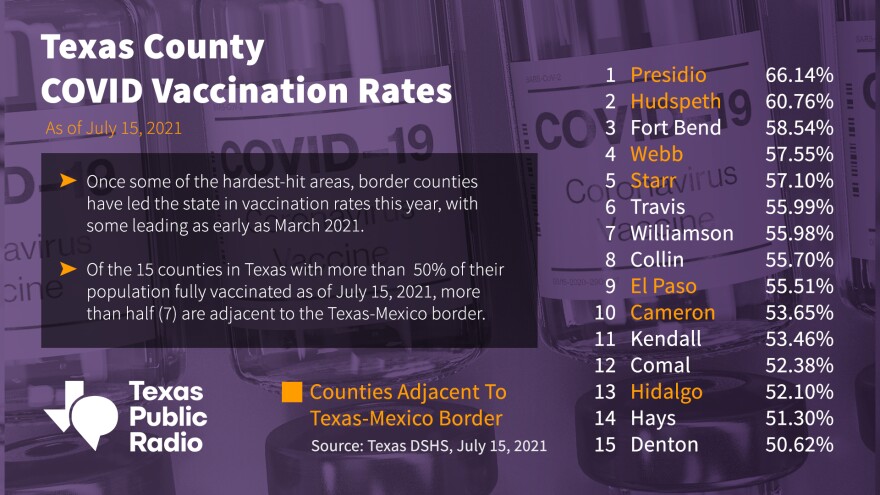In summer 2020, as the pandemic ravaged communities across the country, national media placed the Texas-Mexico border region in the limelight as a coronavirus hot spot. At the time, death rates in the Rio Grande Valley surpassed the national average.
The surge in infections came only weeks after Gov. Greg Abbott’s executive order to reopen the Texas economy on May 1, 2020, took effect. For a vulnerable community with a high rate of underlying health conditions and a low rate of insured individuals, the results were drastic.
The response from health officials on the border since then has created a dramatic turnaround for the region, as border communities are now some of the most highly-vaccinated in the state.
As early as this March, vaccination rates in the Rio Grande Valley were trending up beyond the rest of Texas. By early June, border counties were leading the state in COVID-19 immunization rates. This trend has continued through July, as currently half of all the counties in Texas whose population is more than 50% fully vaccinated are adjacent to the Texas-Mexico border.

But strong immunization rates may not prevent a new surge in cases from the latest coronavirus variant among people who remain unvaccinated in the region.
On Thursday, health officials in the Rio Grande Valley confirmed the first case of the Delta variant on the border. An unvaccinated 33 year-old man from that region tested positive for the strain after being hospitalized while traveling out of state.
This variant of the coronavirus is the most contagious strain to be discovered, with some studies showing death rates from Delta to be as much as 120% higher than previous variants. The Centers for Disease Control and Prevention reported this week that Delta is currently the source of 58% of all coronavirus cases in the country, up from just 3% in late May.
The variant has already caused outbreaks in Texas counties beyond the border region. Communities with the lowest vaccination rates in the state are the ones most affected by the new strain.
Authorities on the border are now again asking the state for more resources to deal with the new Delta variant. This time, they are doing it in anticipation of a rise in future cases instead of in response to an increase in infections that had already happened.
Although Delta has not yet reached Webb County, Laredo Health Authority Dr. Victor Trevino sent in a request to the Texas Department of State Health Services (DSHS) this week for additional staff members for local hospitals as well as an increase in medical supplies for the region.
In Hidalgo County, where the Delta border case may have originated, Judge Richard Cortez asked for direct access to variant testing supplies that could be used locally. Currently, local hospitals test for variants through a state program with the DSHS, and results can take up to 5 weeks.
“We’re pretty sure it has reached the Valley as it’s almost everywhere else,” Cortez told Valley Central. “The unfortunate thing about this variant is we don’t have any supplies to test them.”
Leaders in the region are also reaching out across the border to the northern part of the Mexican state of Tamaulipas in an effort to work more closely with health authorities in Mexico.
This week, Hidalgo County launched an initiative that will allow the county and the City of McAllen to work with Customs and Border Protection to transport maquiladora workers from Mexico to be vaccinated in the U.S. Three thousand Mexican workers are expected to be vaccinated through the program this week.
Officials said the maquiladora industry represented an important economic engine for the border and the country.
“A majority of the ventilator tubing used to help COVID patients in hospitals is produced in Reynosa, Mexico,” Hidalgo County Health and Human Services Chief Administrative Officer Eddie Olivarez told Border Report. “Keeping that workforce healthy so coronavirus patients can be treated nationwide is tantamount.”
Across the border from El Paso, health officials in Juarez are ramping up vaccination operations across the city. Leaders in northern Mexico are setting high goals this week for immunization rates as they work with U.S. officials to open land ports to non-essential traffic for the first time since March 2020.
TPR was founded by and is supported by our community. If you value our commitment to the highest standards of responsible journalism and are able to do so, please consider making your gift of support today.


